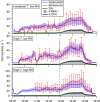Effect of Ozone, Clothing, Temperature, and Humidity on the Total OH Reactivity Emitted from Humans
- PMID: 34591444
- PMCID: PMC8529706
- DOI: 10.1021/acs.est.1c01831
Effect of Ozone, Clothing, Temperature, and Humidity on the Total OH Reactivity Emitted from Humans
Abstract
People influence indoor air chemistry through their chemical emissions via breath and skin. Previous studies showed that direct measurement of total OH reactivity of human emissions matched that calculated from parallel measurements of volatile organic compounds (VOCs) from breath, skin, and the whole body. In this study, we determined, with direct measurements from two independent groups of four adult volunteers, the effect of indoor temperature and humidity, clothing coverage (amount of exposed skin), and indoor ozone concentration on the total OH reactivity of gaseous human emissions. The results show that the measured concentrations of VOCs and ammonia adequately account for the measured total OH reactivity. The total OH reactivity of human emissions was primarily affected by ozone reactions with organic skin-oil constituents and increased with exposed skin surface, higher temperature, and higher humidity. Humans emitted a comparable total mixing ratio of VOCs and ammonia at elevated temperature-low humidity and elevated temperature-high humidity, with relatively low diversity in chemical classes. In contrast, the total OH reactivity increased with higher temperature and higher humidity, with a larger diversity in chemical classes compared to the total mixing ratio. Ozone present, carbonyl compounds were the dominant reactive compounds in all of the reported conditions.
Keywords: human skin emissions; indoor chemistry; indoor ozone; ozone deposition velocity; volatile organic compounds.
Conflict of interest statement
The authors declare no competing financial interest.
Figures




Similar articles
-
The Indoor Chemical Human Emissions and Reactivity (ICHEAR) project: Overview of experimental methodology and preliminary results.Indoor Air. 2020 Nov;30(6):1213-1228. doi: 10.1111/ina.12687. Epub 2020 Jun 7. Indoor Air. 2020. PMID: 32424858 Review.
-
Emission Rates of Volatile Organic Compounds from Humans.Environ Sci Technol. 2022 Apr 19;56(8):4838-4848. doi: 10.1021/acs.est.1c08764. Epub 2022 Apr 7. Environ Sci Technol. 2022. PMID: 35389619 Free PMC article.
-
Ozone reaction with clothing and its initiated VOC emissions in an environmental chamber.Indoor Air. 2014 Feb;24(1):49-58. doi: 10.1111/ina.12058. Epub 2013 Aug 9. Indoor Air. 2014. PMID: 23841649
-
Total OH Reactivity of Emissions from Humans: In Situ Measurement and Budget Analysis.Environ Sci Technol. 2021 Jan 5;55(1):149-159. doi: 10.1021/acs.est.0c04206. Epub 2020 Dec 9. Environ Sci Technol. 2021. PMID: 33295177 Free PMC article.
-
A review of phyto- and microbial-remediation of indoor volatile organic compounds.Chemosphere. 2024 Jul;359:142120. doi: 10.1016/j.chemosphere.2024.142120. Epub 2024 Apr 24. Chemosphere. 2024. PMID: 38670503 Review.
Cited by
-
Indoor Volatile Organic Compounds: Concentration Characteristics and Health Risk Analysis on a University Campus.Int J Environ Res Public Health. 2023 May 16;20(10):5829. doi: 10.3390/ijerph20105829. Int J Environ Res Public Health. 2023. PMID: 37239556 Free PMC article.
-
Emissions of Volatile Organic Compounds from Human Occupants in a Student Office: Dependence on Ozone Concentration.ACS Environ Au. 2023 Nov 3;4(1):3-11. doi: 10.1021/acsenvironau.3c00043. eCollection 2024 Jan 17. ACS Environ Au. 2023. PMID: 38250339 Free PMC article.
-
The influence of personal care products on ozone-skin surface chemistry.PLoS One. 2022 Sep 29;17(9):e0268263. doi: 10.1371/journal.pone.0268263. eCollection 2022. PLoS One. 2022. PMID: 36174009 Free PMC article.
-
Indoor Air Sources of Outdoor Air Pollution: Health Consequences, Policy, and Recommendations: An Official American Thoracic Society Workshop Report.Ann Am Thorac Soc. 2024 Mar;21(3):365-376. doi: 10.1513/AnnalsATS.202312-1067ST. Ann Am Thorac Soc. 2024. PMID: 38426826 Free PMC article.
-
Global burden of disease study on COPD in the older adult: comprehensive analysis of environmental factors and interaction effects.Front Public Health. 2025 May 30;13:1597793. doi: 10.3389/fpubh.2025.1597793. eCollection 2025. Front Public Health. 2025. PMID: 40520278 Free PMC article.
References
-
- Klepeis N. E.; Nelson W. C.; Ott W. R.; Robinson J. P.; Tsang A. M.; Switzer P.; Behar J. V.; Hern S. C.; Engelmann W. H. The National Human Activity Pattern Survey (NHAPS): A Resource for Assessing Exposure to Environmental Pollutants. J. Exposure Sci. Environ. Epidemiol. 2001, 11, 231–252. 10.1038/sj.jea.7500165. - DOI - PubMed
-
- Press Corner: https://ec.europa.eu/commission/presscorner/home/en (accessed Jan 24, 2021).
-
- US EPA, O. Introduction to Indoor Air Quality https://www.epa.gov/indoor-air-quality-iaq/introduction-indoor-air-quality (accessed Jan 24, 2021).
-
- Ault A. P.; Grassian V. H.; Carslaw N.; Collins D. B.; Destaillats H.; Donaldson D. J.; Farmer D. K.; Jimenez J. L.; McNeill V. F.; Morrison G. C.; O’Brien R. E.; Shiraiwa M.; Vance M. E.; Wells J. R.; Xiong W. Indoor Surface Chemistry: Developing a Molecular Picture of Reactions on Indoor Interfaces. Chem 2020, 6, 3203–3218. 10.1016/j.chempr.2020.08.023. - DOI - PMC - PubMed
Publication types
MeSH terms
Substances
Grants and funding
LinkOut - more resources
Full Text Sources
Medical

